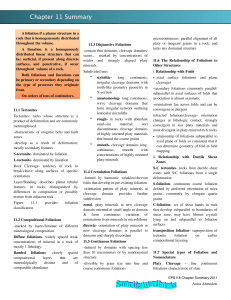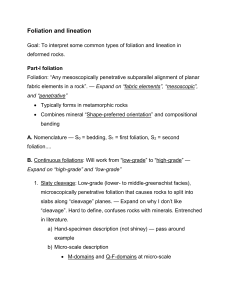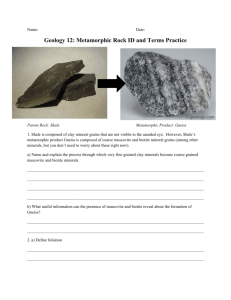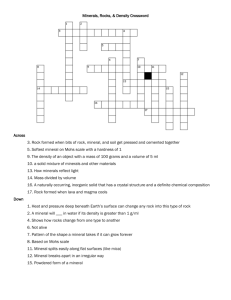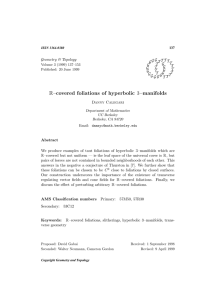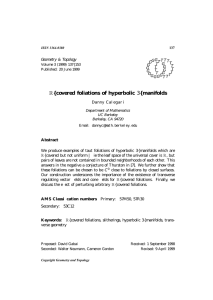1 EPS116 Chapter 11 Anisa Ahmadzai 2011 Jessica Banaszak
advertisement
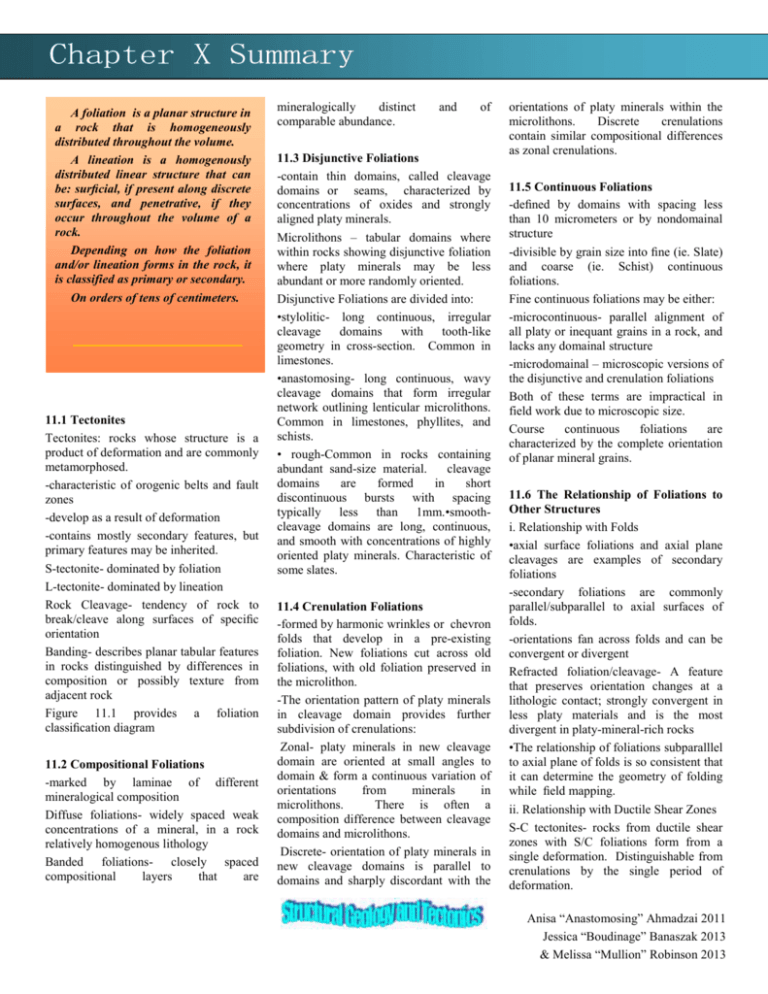
A foliation is a planar structure in a rock that is homogeneously distributed throughout the volume. A lineation is a homogenously distributed linear structure that can be: surficial, if present along discrete surfaces, and penetrative, if they occur throughout the volume of a rock. Depending on how the foliation and/or lineation forms in the rock, it is classified as primary or secondary. On orders of tens of centimeters. 11.1 Tectonites Tectonites: rocks whose structure is a product of deformation and are commonly metamorphosed. -characteristic of orogenic belts and fault zones -develop as a result of deformation -contains mostly secondary features, but primary features may be inherited. S-tectonite- dominated by foliation L-tectonite- dominated by lineation Rock Cleavage- tendency of rock to break/cleave along surfaces of specific orientation Banding- describes planar tabular features in rocks distinguished by differences in composition or possibly texture from adjacent rock Figure 11.1 provides a foliation classification diagram 11.2 Compositional Foliations -marked by laminae of different mineralogical composition Diffuse foliations- widely spaced weak concentrations of a mineral, in a rock relatively homogenous lithology Banded foliations- closely spaced compositional layers that are mineralogically distinct comparable abundance. and of 11.3 Disjunctive Foliations -contain thin domains, called cleavage domains or seams, characterized by concentrations of oxides and strongly aligned platy minerals. Microlithons – tabular domains where within rocks showing disjunctive foliation where platy minerals may be less abundant or more randomly oriented. Disjunctive Foliations are divided into: •stylolitic- long continuous, irregular cleavage domains with tooth-like geometry in cross-section. Common in limestones. •anastomosing- long continuous, wavy cleavage domains that form irregular network outlining lenticular microlithons. Common in limestones, phyllites, and schists. • rough-Common in rocks containing abundant sand-size material. cleavage domains are formed in short discontinuous bursts with spacing typically less than 1mm.•smoothcleavage domains are long, continuous, and smooth with concentrations of highly oriented platy minerals. Characteristic of some slates. 11.4 Crenulation Foliations -formed by harmonic wrinkles or chevron folds that develop in a pre-existing foliation. New foliations cut across old foliations, with old foliation preserved in the microlithon. -The orientation pattern of platy minerals in cleavage domain provides further subdivision of crenulations: Zonal- platy minerals in new cleavage domain are oriented at small angles to domain & form a continuous variation of orientations from minerals in microlithons. There is often a composition difference between cleavage domains and microlithons. Discrete- orientation of platy minerals in new cleavage domains is parallel to domains and sharply discordant with the 1 orientations of platy minerals within the microlithons. Discrete crenulations contain similar compositional differences as zonal crenulations. 11.5 Continuous Foliations -defined by domains with spacing less than 10 micrometers or by nondomainal structure -divisible by grain size into fine (ie. Slate) and coarse (ie. Schist) continuous foliations. Fine continuous foliations may be either: -microcontinuous- parallel alignment of all platy or inequant grains in a rock, and lacks any domainal structure -microdomainal – microscopic versions of the disjunctive and crenulation foliations Both of these terms are impractical in field work due to microscopic size. Course continuous foliations are characterized by the complete orientation of planar mineral grains. 11.6 The Relationship of Foliations to Other Structures i. Relationship with Folds •axial surface foliations and axial plane cleavages are examples of secondary foliations -secondary foliations are commonly parallel/subparallel to axial surfaces of folds. -orientations fan across folds and can be convergent or divergent Refracted foliation/cleavage- A feature that preserves orientation changes at a lithologic contact; strongly convergent in less platy materials and is the most divergent in platy-mineral-rich rocks •The relationship of foliations subparalllel to axial plane of folds is so consistent that it can determine the geometry of folding while field mapping. ii. Relationship with Ductile Shear Zones S-C tectonites- rocks from ductile shear zones with S/C foliations form from a single deformation. Distinguishable from crenulations by the single period of deformation. EPS116 Chapter 11 Anisa “Anastomosing” Ahmadzai 2011 Anisa Ahmadzai 2011 Jessica “Boudinage” Banaszak2013 2013 Jessica Banaszak & Melissa Robinson & Melissa “Mullion” Robinson 2013 S-foliation- continuous coarse foliation defined by preferred orientation of mica grains, and commonly by elongate quartz grains. C-foliation- set of shear bands in rock that develop subparallel to boundaries of the shear zone, and may have fibrous crystals (slickenfibers) lying on and subparallel to foliation surfaces. -transposition foliation- superposition of tectonite foliation on earlier compositional layering. Can be dated isotopically. 11.7 Special types of Foliation and Nomenclature Slaty Cleavage - refers fine continuous foliations characteristic of slate. “Rocks with slaty cleavage traditionally have been a valuable source of materials for roofing slates and blackboards.” Foliation causes a strong cleavage in the rock, so the rock breaks easily and weathers preferentially. Phyllitic Cleavage - resembles slaty cleavage but the grain size of rock slightly coarser. Characterizes phyllites. In hand samples, the surface of samples has a sheen. Also has preferential weathering patterns. Schistosity – refers to foliation found in coarse-grained, mica-rich, medium- to high grade metamorphic rocks with chlorite, biotite, or muscovite defining the foliation Mineral grains are coarse enough to be visible. Gneissic Foliation- develop in gneisses – coarse grained, metamorphic rocks - in which platy minerals are sparse or absent. This foliation provides weak cleavage at best. 11.8 Structural Lineations -defined by the preferred orientation of linear structure contained within a rock. discrete lineationsformed by deformation of discrete objects. For example: ooids, pebbles, fossils, and alteration spots constructed lineations- formed from planar features constructed or deformed during deformation and include the intersection of two foliations, crenulation hinge lines, boudin lines, structural slickenlines, and mullions. boudins- linear segments of a layer formed when the layer has been pulled apart along periodically spaced lines of separation called boudin lines. pinch-and-swell structures are periodic oscillations in the thickness of a bed with pinches becoming thinner as the amount of lengthening of the bed increases. mullionslinear fluted structures developed within a rock or at lithologic interfaces. map geometry of fold hinges through these structures -Lineations may be found parallel or perpendicular to fold axes and also as arbitrary angles to fold axes References & Resources Robert J. Twiss, Eldridge M. Moores, Structural Geology 2nd edition, (W. H. Freeman), p. 297-317, 2006 11.9 Mineral Lineations -consist of preferred orientation of either single elongate mineral grains or elongate polycrystalline aggregates -Mineral grain lineations are formed by the parallel alignment of 1) individual acicular mineral grains such as amphibole, 2) by grains of minerals that have been stretched into an elongate shape, or 3) by mineral fibers that have grown in a preferred orientation. Polycrystalline mineral lineations formed by the preferred orientation of elongate clusters of grains of a particular mineral measuring at least a few grains in diameter. Examples of these structures are rods, mineral cluster lineations, pencil lineations, and nonfibrous overgrowths. 11.10 Associations of Lineations With Other Structures i. Lineations and Foliations -Some lineations are defined at least in part by foliations, and must be parallel -Lineations may develop on surfaces other than foliations like fault surfaces ii. Lineations and Folds -This relationship can decipher structural geometry of an area and is useful when interpreting conditions under which the structures formed. -Because lineations are usually smaller structures than folds it may be easier to 2 EPS116 Chapter 11 Anisa “Anastomosing” Ahmadzai 2011 Anisa Ahmadzai 2011 Jessica “Boudinage” Banaszak2013 2013 Jessica Banaszak & Melissa Robinson & Melissa “Mullion” Robinson 2013
